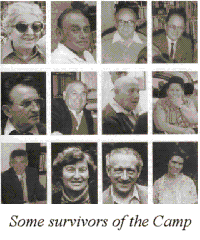 Because
during the summer of the year of 1943 the number
of arriving transports from all across Europe
decreased, fear arose in the minds of the
prisoners of Lager I and Lager II that the end of
the existence of the camp was nearing which meant
the end of their lifes they fought so hard for
every single day in the camp. Birkenau's
capacities grew to a monster during 1943 with its
four huge crematoria which made Sobibors killing
machine just a tiny thing compared to that.
Sobibor and the other exterminationcamps were no
longer needed. Belzec was already torn down in
the spring of 1943 and Treblinka and Sobibor were
to follow that example. Or Sobibor maybe not?
That was the question. On the north site of the
camp a new part was established better known as
Lager IV or Nordlager which was meant for
cleaning captured Russian weapons and ammonition
for re-use by the Germans. The Nazis were in
desperate need due to the bad situation on the
eastern front, North-Africa and the bombings on
German cities by the Allied. When Russian POWs
(prisoners of war) entered the camp a whole new
situation emerged. Most POWs were directly sent
to the gaschambers but a group of 70 not. It late
appeared a major mistake by the camp chief of
staff to let them live. At the time the POWs came
into the camp in September the number of workers
in Lager III was already brought back from 150 to
50: the others were no longer needed and
therefore killed. Because
during the summer of the year of 1943 the number
of arriving transports from all across Europe
decreased, fear arose in the minds of the
prisoners of Lager I and Lager II that the end of
the existence of the camp was nearing which meant
the end of their lifes they fought so hard for
every single day in the camp. Birkenau's
capacities grew to a monster during 1943 with its
four huge crematoria which made Sobibors killing
machine just a tiny thing compared to that.
Sobibor and the other exterminationcamps were no
longer needed. Belzec was already torn down in
the spring of 1943 and Treblinka and Sobibor were
to follow that example. Or Sobibor maybe not?
That was the question. On the north site of the
camp a new part was established better known as
Lager IV or Nordlager which was meant for
cleaning captured Russian weapons and ammonition
for re-use by the Germans. The Nazis were in
desperate need due to the bad situation on the
eastern front, North-Africa and the bombings on
German cities by the Allied. When Russian POWs
(prisoners of war) entered the camp a whole new
situation emerged. Most POWs were directly sent
to the gaschambers but a group of 70 not. It late
appeared a major mistake by the camp chief of
staff to let them live. At the time the POWs came
into the camp in September the number of workers
in Lager III was already brought back from 150 to
50: the others were no longer needed and
therefore killed.
Among the civil prisoners a movement for an
escape already had come into existance under the
authority of Leon Felhendler, a charismatic
person trusted by everyone. This group had to be
small because not everyone in Sobibor could be
trusted and there were disloyal people and
collaborators with the Germans (to save their own
lives) among the prisoners who could easily
betray the members of the group. But this group
was not able to come up with something realistic
and didn't have to powers to put an escape or
revolt into a reality. With the arrival of the
POWs this changed. Their leader Alexander
Petjerski, named Sacha, was an officer in the
Russian army who began immediatly after arriving
building plans for an escape, first for him and
his fellow soldiers alone, later together with
the group of Felhendler. The only solution was a
mass revolt and escape. No one was to be left
behind because it surely meant their deaths.
Death caused by escape was prefered above death
by gaschamber.Such a mass
revolt and escape became organized a few weeks
after arrival of the POWs. First the newcomers
had to be checked out by Felhendler and his men
if they were to be trusted and were willing to
cooperate with his group. In the beginning they
were not ready willing to cooperate but, after
Sacha and his men knew what was happening in the
camp, the situation changed. A misleading
operation was put up to keep the Germans and
their companions, the Ukrainian guards, unknown
of what was going on. They came to know that the
guards only had 10 bullets for their guns when
they were on duty and none when they were off
duty. To have a succesful revolt and escape some
guns and ammonition were needed. Also it was
important to mislead Wagner and to escape when he
was not in the camp because he was the smartest
German of all and he could have noticed that
something was being organized by the prisoners.
When the commitee came to know that Wagner and
his staff would be absent from the camp the date
was set: 13 october 1943. Beforehand, Kapo
Berliner had to be killed because he was a
wellknown collaborator.
 When the day
came, most of the prisoners already knew what was
going to happen, except some groups were left out
of it. These were mostly Dutch and German Jews,
the reason why only one Dutch Jew survived. A
short while before the uprising would have begun,
a company of SS soldiers taking a break from the
front appeared in the canteen barraks of the
camp, a big disappointment for the prisoners,
making them to postpone the outbreak till a day
later, the 14th. That day became famous
throughout the history of the camp and of the
shoa. Revolting later would have been unpossible
because Wagner and his men would have been back
on the 15th. When the day
came, most of the prisoners already knew what was
going to happen, except some groups were left out
of it. These were mostly Dutch and German Jews,
the reason why only one Dutch Jew survived. A
short while before the uprising would have begun,
a company of SS soldiers taking a break from the
front appeared in the canteen barraks of the
camp, a big disappointment for the prisoners,
making them to postpone the outbreak till a day
later, the 14th. That day became famous
throughout the history of the camp and of the
shoa. Revolting later would have been unpossible
because Wagner and his men would have been back
on the 15th.
On the 14th, the ultimate day
of the escape, the prisoners killed one by one
the most important Nazis of the camp by luring
them into a trap and then stabbing them to death
with knifes and axes. This way they killed 12 of
the 17 present Germans (and a couple of
Ukrainians) and captured there weaponary. No
single SS-men had a clue what was happening. When
gasmeister Bauer discovered a dead guard just
short for the eveningcall, his shooting alarmed
the prisoners and on a command of Sacha the
revolt began.
Not every prisoner decided to
take part in the revolt and the escape but only a
365 of the total amount tried to find their way
outside. The minefields and the machineguns on
the towers killed many of the escapees sothat
prisoners had to run over the death bodies of
their fellow comrades. 158 were killed by mines
and machinegun fire. The others arrived savely in
the woods surrounding the camp. The revolt was
successful and brought the Germans their earned
defeat. No Jews would be gassed after this event,
only the men who stayed behind and the ones that
had to break down the camp would the last to be
killed.
What happened to the ones that
succeeded to manage to enter the woods? Knowing
that only 47 survived the war (of which 5 of
earlier escapes), the others must have been
captured or killed. We know that the Germans
caught 107 men and women and that 53 were killed
by the Polish resistance, among them Leon
Felhendler and Kitty Gokkes on the last day of
the war.
This was the story of the
Sobibor Deathcamp in short.

|
